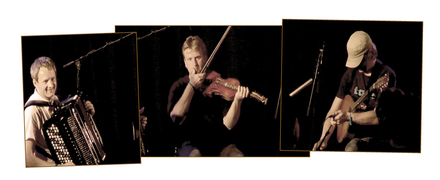| Adr.: |
v/Nils Øyvind Bergset, Ivan Bjørndalsgate 4 N- 0472 Oslo |
| Tlf1: | + 47 416 39 567 |
| E-post: | Send e-post |
| Web: | Nettside |
Hått
Round dances and the associated music spread throughout the rural communities towards the end of the 18th century. The waltz was the first to arrive, and quickly became very popular. It was followed shortly after by various forms of polka. The mazurka appeared around 1850, and the reinlender a decade later. The new tunes were quickly adapted to existing instruments, such as the Hardanger fiddle. Later on, new instruments were introduced, such as the diatonic (around 1840) and chromatic (from 1900 onwards) accordion. The new tunes were performed in the same playing style as the older, rural dance tunes, and there were probably instances of gangar tunes being played with a reinlender rhythm. The influence was discernible in the use of old-style tonalities, bowing techniques, melodic lines and embellishments. Later on, the tunes attained a standardized, modern soundcharacter, but Hått’s performances are entirely in the old style.
The round dances were at the height of their popularity between 1870 and 1920. The primary exponents of round dance music at this time were Lars Fykerud and Anders Ødegarden (1871–1943) in Telemark and Numedal; Ulrik i Jensestogun (1850–1919) in Valdres, said to have had 300 waltzes in his repertoire; and Ola Mosafinn (1828–1912), Sjur Helgeland (1858–1924) and Nils Tjoflot (1865–1989) in Western Norway.
At the height of Norwegian nationalism in the latter half of the 19th century, the Hardanger fiddle and the music associated with it came to be regarded as something of a national symbol. Many Hardanger fiddlers viewed the growing popularity of the chromatic accordion and contemporary dances such as the tango, foxtrot, one-step and charleston as a threat to their own status and what they had begun to refer to as the ‘old national music’.
Attitudes toward the round dances changed after W.W.II. An upsurge in interest during the 1960’s became a national success, particularly in areas dominated by ordinary fiddle, where groups of fiddle, accordion, guitar and bass became common.
Over a span of 200 years, then, round dance music has evolved from solo performance to combos and fiddlers’ groups. And then Hått was formed in 1997 as a duo (Per Anders and Øyvind). Anders joined in 1999.
Hått
Per Anders Buen Garnås (b. 1980) Hardanger fiddle Anders Erik Røine (b. 1971) guitar, octave mandolin Nils Øyvind Bergset (b. 1973) accordion




